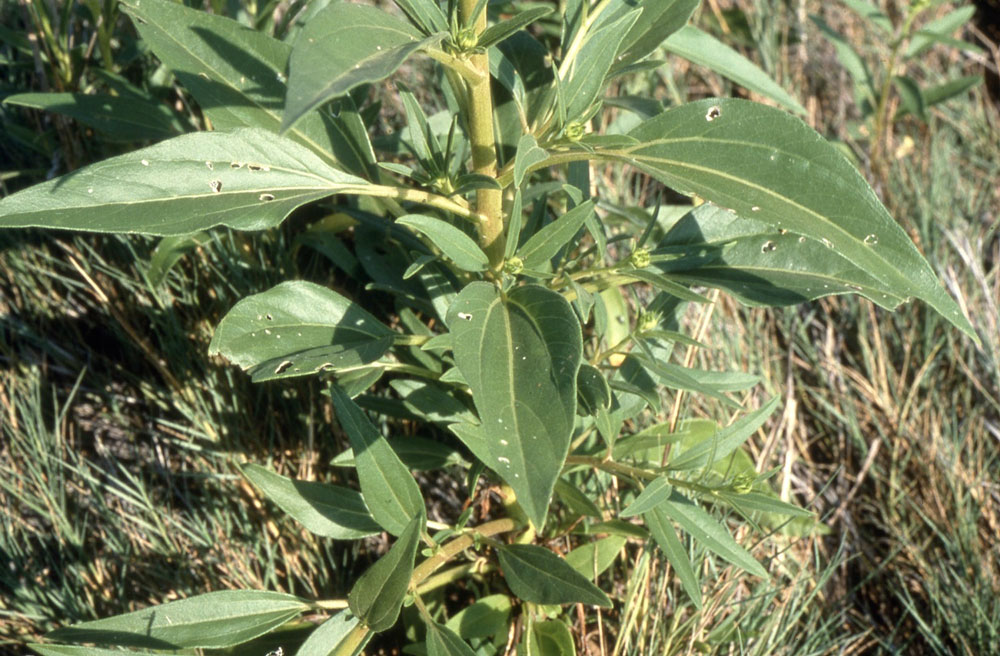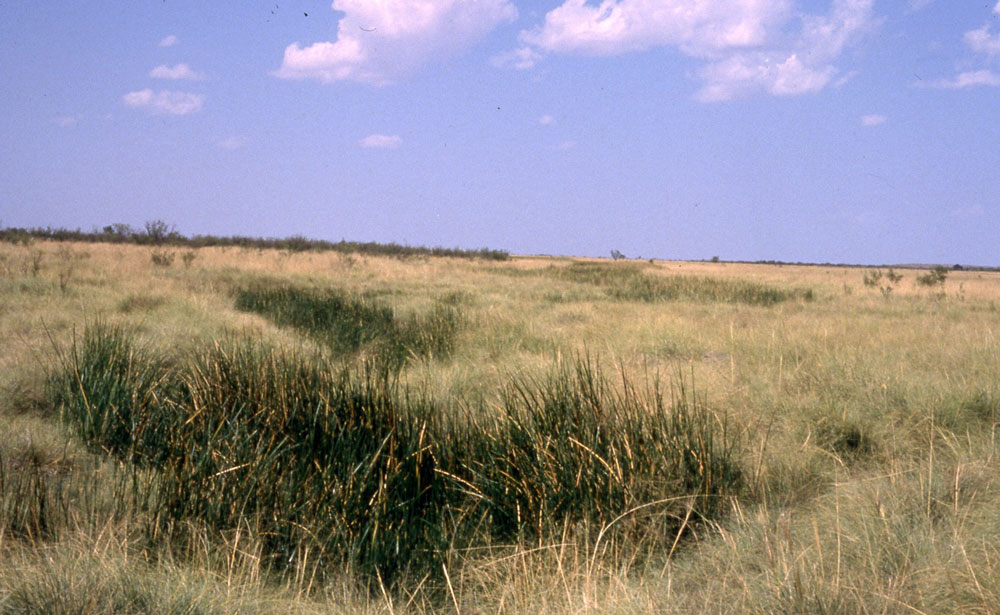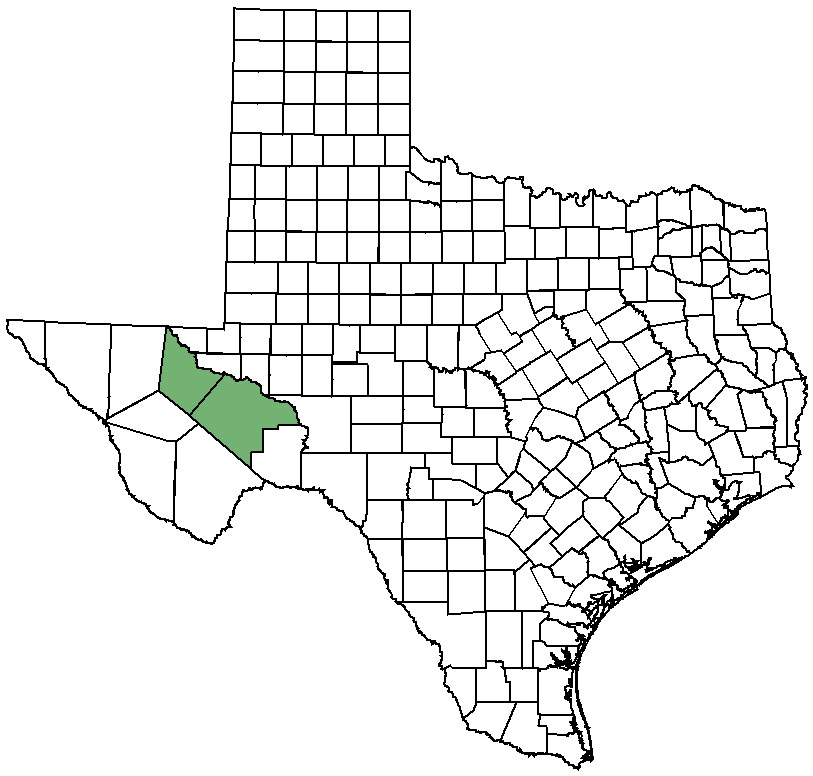Federal and State Listed Species of Texas:
Pecos sunflower
Global Location
Pecos sunflower grows in West Texas in Pecos and Reeves counties as well as in five counties in New Mexico.
null
Credit:
Description
Pecos sunflower is an erect annual with mostly hairless stems, which reach from 1-3 m in height. Leaves lower on the stem are opposite one another, whereas higher up, the leaves become alternate. Leaves are narrowly teardrop shaped, are usually 7-15 cm long, and have smooth leaf edges (the lower leaves may have a few small teeth). Three conspicuous, roughly parallel veins run outward from the base of the leaf toward the tip. Flower heads occur 3-5 per branch and are 5-7 cm in diameter. Two to three overlapping rows of green, narrowly teardrop shaped, leaf-like structures (each 2-4.5 mm wide) closely cup the outside base of the flower head. Flower heads have a reddish-purple center, composed of about 50 tiny flowers (disc florets), surrounded by 12-20 yellow petals (each petal is the largest part of an otherwise tiny flower called a ray floret). The seeds are small (3-4 mm long) and lack hairs but have 2 small scales at their base.

Pecos sunflower leaves are narrowly teardrop shaped, have smooth edges, and have three conspicuous, roughly parallel veins.
Credit: Jackie Poole - Texas Parks & Wildlife Dept.
Pecos sunflower is an erect annual with 3-5 flower heads per branch.
Credit: Jackie Poole - Texas Parks & Wildlife Dept.
null
Credit:
Similar Species
To the casual observer, the common sunflower (Helianthus annuus) can resemble the Pecos sunflower. However, the common sunflower has broad, triangular leaves, hairy stems, and leaf veins that are not as conspicuous as Pecos sunflower. The common sunflower also has wider (5-8 mm), more or less triangular-shaped, leaf-like structures cupping the outside base of the flower head, and starts flowering as early as March.
The common sunflower has broad, triangular leaves, hairy stems, and leaf veins that are not as conspicuous as Pecos sunflower. The leaf-like structures cupping the outside base of the flower head are also wider and more or less triangular-shaped.
Credit: Anna Strong - Texas Parks & Wildlife Dept.
null
Credit:
null
Credit:
null
Credit:
null
Credit:
null
Credit:
Floral Characters
nullLeaf Characters
nullnull
Credit:
null
Credit:
null
Credit:
Habitat
Pecos sunflower occurs in permanently wet (infrequently flooded) soils associated with cienegas (desert marshes with high salt content). Pecos sunflower, saltgrass, and other saline-tolerant species occupy a moisture gradient between the permanently flooded pool dominated by bulrush and the more upland, drier sites dominated by alkali sacaton.

Habitat of Pecos sunflower.
Credit: Jackie Poole - Texas Parks & Wildlife Dept.
Life Cycle Events
Flowering occurs from August to November.
Survey Season
As an annual, Pecos sunflower is easiest to find during its flowering season, August to November.
null
Additional Information
- Rare Plants of Texas
- U.S. Fish and Wildlife Service
- NatureServe
- Center for Plant Conservation
- Flora of North America
- Poole, J.M. 1992. Puzzle sunflower status report update. Section 6 final report. Austin: Texas Parks & Wildlife Department.
- Poole, J.M. and G.K. Janssen. 1997. Managing and monitoring rare and endangered plants on highway right-of-ways in Texas. Section 6 final report. Austin: Texas Parks & Wildlife Department.
- Van Auken, O.W. 2002. Management of the puzzle sunflower (Helianthus paradoxus). Section 6 final report. Austin: Texas Parks & Wildlife Department.

Comments
In the 1990s scientists confirmed what previous researchers had suspected, that Pecos sunflower evolved through an ancient cross between the common sunflower and prairie sunflower (Helianthus petiolaris). Having thoroughly examined DNA and various plant structures over the last half century, scientists have found evidence that repeatedly supports this conclusion (studies of Heiser, Rieseberg and collaborators). Pecos sunflower is a true species, not an intermittent hybrid arising randomly to only die before reproducing offspring.